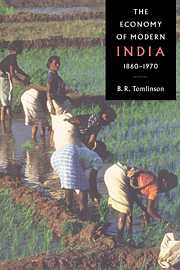Book contents
- Frontmatter
- 1 Introduction: development and underdevelopment in colonial India
- 2 Agriculture 1860–1950: land, labour and capital
- 3 Trade and manufacture, 1860–1945: firms, markets and the colonial state
- 4 The state and the economy, 1939–1970: the emergence of economic management in India
- 5 Conclusion
- Bibliographical essay
- Index
- THE NEW CAMBRIDGE HISTORY OF INDIA
- Map I.I India in 1937-8
- References
3 - Trade and manufacture, 1860–1945: firms, markets and the colonial state
Published online by Cambridge University Press: 28 March 2008
- Frontmatter
- 1 Introduction: development and underdevelopment in colonial India
- 2 Agriculture 1860–1950: land, labour and capital
- 3 Trade and manufacture, 1860–1945: firms, markets and the colonial state
- 4 The state and the economy, 1939–1970: the emergence of economic management in India
- 5 Conclusion
- Bibliographical essay
- Index
- THE NEW CAMBRIDGE HISTORY OF INDIA
- Map I.I India in 1937-8
- References
Summary
The history of trade and manufacture in colonial India is dominated by counter-factual questions about the process of industrialisation. The South Asian subcontinent had a large and active trading and manufacturing economy in the seventeenth and eighteenth centuries; its handicraft manufactures supplied a wide range of Asian and European markets for cotton goods, and its businessmen played a full part in a trading world based on the Indian Ocean that rivalled that of any other region. The onset of British rule through the agency of the East India Company was linked closely to political battles over control of the export trade, and over the supply of credit and liquidity for mercantilist regimes and the financial and trading networks that they spawned in the second half of the eighteenth century. Throughout the nineteenth century India was host to a large and diverse expatriate business community that created the modern industrial sector of Bengal; from the 1870s onwards Indian-born businessmen were also prominent in establishing a mechanised cotton industry, and in the first half of the twentieth century Indian entrepreneurs became the dominant force in most business sectors. Between 1870 and 1947 India was an industrialising country in the sense that manufacturing output was growing as a share of national income, that value added per worker was increasing, and that productivity was higher and rising faster in the secondary sector than in agriculture. In output terms the Indian cotton and jute industries were significant in global terms by 1914, while in 1945 India was the tenth largest producer of manufactured goods in the world.
Keywords
- Type
- Chapter
- Information
- The Economy of Modern India, 1860–1970 , pp. 92 - 155Publisher: Cambridge University PressPrint publication year: 1993
References
- 1
- Cited by

